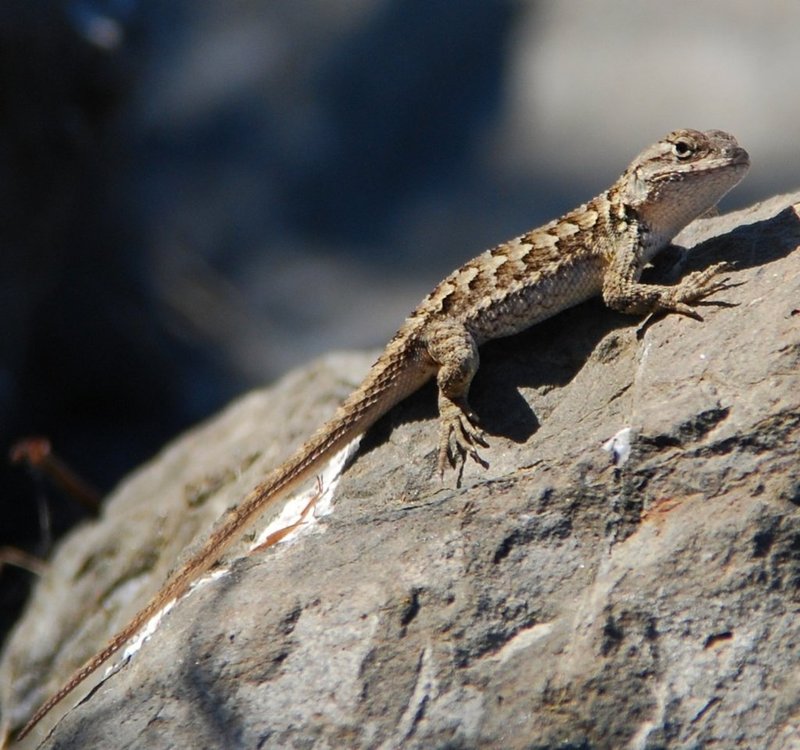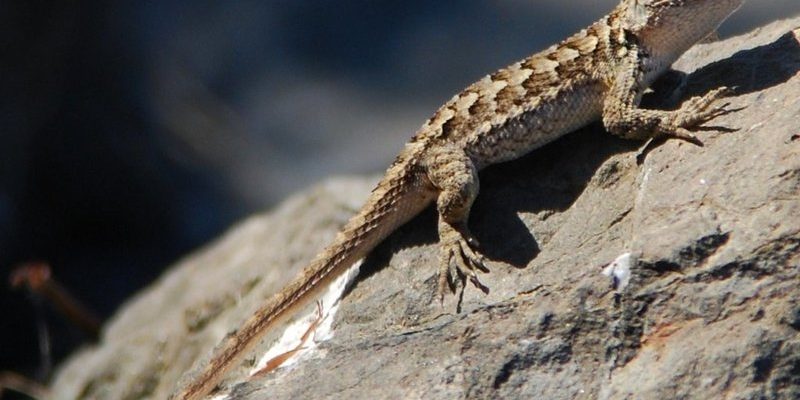
If you’ve ever spent time outdoors in the western United States, you might have stumbled upon a Western Fence Lizard. These small, agile reptiles are a common sight, often basking on rocks or fences. Picture a tiny creature, with scales that glimmer in the sunlight, darting across the ground with a surprising speed. They’re like little acrobats of the wild, blending into their surroundings while keeping a watchful eye out for both predators and prey.
The Western Fence Lizard is more than just a charming little critter. They play a vital role in their ecosystem, helping to control insect populations and serving as food for various birds and mammals. If you’re curious about their habits, habitat, and how they thrive in their environment, you’re in luck. This article will unravel the fascinating world of these intriguing lizards.
What is a Western Fence Lizard?
The Western Fence Lizard, also known as the Sceloporus occidentalis, is a species of lizard that belongs to the family Phrynosomatidae. These lizards are primarily found across the western regions of North America, from California to Texas and even into some parts of Canada. Their preferred habitats include rocky hillsides, grasslands, and even suburban areas, making them quite adaptable.
One of the most distinctive features of the Western Fence Lizard is its coloration. These lizards typically exhibit a combination of gray, brown, and blue hues, helping them camouflage in their natural habitat. Males are often brighter, showcasing vibrant blue patches on their bellies and throats during mating season. This colorful display isn’t just for show; it plays a crucial role in attracting females and establishing dominance among males.
These lizards are diurnal, meaning they are most active during the day. You’ll often see them basking in the sun to regulate their body temperature or scurrying around in search of food. Their diet mainly consists of insects, such as ants, beetles, and other small invertebrates, making them excellent pest controllers in gardens and yards.
Physical Characteristics
The Western Fence Lizard is relatively small, averaging about 5 to 8 inches in length from snout to tail. This might sound tiny, but these lizards are equipped with impressive physical abilities. Their long toes and sharp claws allow them to climb and cling to rough surfaces effortlessly. This skill not only aids in escaping predators but also helps them access food. Imagine a tiny gymnast, skillfully navigating a vertical fence — that’s the agility of the Western Fence Lizard!
One of the standout features is their rough, spiny skin, which offers protection against predators. This tough exterior isn’t just a defense mechanism; it helps them retain moisture, vital for their survival in varying environments. They also have a unique ability to change color slightly, though it’s more about blending in than shifting hues dramatically. Think of them as the world’s smallest chameleons, using their natural camouflage to hide from larger animals.
Interestingly, Western Fence Lizards possess a unique ability to regenerate their tails after losing them, a common occurrence to escape predators. The regrown tail won’t look identical to the original, but it’s still an impressive feat of nature. This remarkable ability is a reminder of how adaptable and resilient these lizards truly are.
Habitat and Range
The Western Fence Lizard is native to the western United States, thriving in a variety of habitats. You’ll spot them in forests, grasslands, rocky hills, and even suburban gardens. Their versatility in habitat choices allows them to find shelter and food sources easily. If you’re hiking through a sunny area with plenty of rocks or fences, keep your eyes peeled; you might just catch a glimpse of one!
These lizards prefer environments that provide ample opportunities for sunbathing and hiding. They often nestle between rocks or under logs to protect themselves from predators and extreme weather. Their range spans from the Pacific Coast to the Rocky Mountains, exhibiting a remarkable adaptability to different terrains and climates.
Understanding their habitat is key to appreciating their role in the ecosystem. As they forage for insects, they help keep pest populations in check, benefiting both natural ecosystems and human-managed spaces. Plus, they serve as prey for various birds and mammals, contributing to a balanced food web. So, the next time you see a Western Fence Lizard basking in the sun, remember, they’re not just soaking up rays; they’re also playing an essential part in their environment.
Behavior and Diet
Western Fence Lizards are fascinating creatures with distinct behaviors that enhance their survival. They are generally territorial and will often engage in displays of dominance, especially during breeding season. Males may puff out their throats and engage in push-up contests to impress females and ward off rival males. Imagine a little dance-off, where the best performer wins the attention of a mate!
When it comes to their diet, these lizards are insectivores, primarily feeding on various bugs. They’ll eat ants, beetles, grasshoppers, and other small invertebrates. Their hunting technique is quite agile and quick, relying on stealth and speed. Watching them dart around, catching prey in their rapid movements, is like witnessing nature’s own little predator in action.
Interestingly, Western Fence Lizards play a role in controlling pest populations. By keeping insect numbers in check, they help maintain a balanced ecosystem. For gardeners, having these lizards around can be a natural form of pest control, reducing the need for chemical pesticides. They might be small, but their impact on the environment is significant!
Reproduction and Lifespan
The breeding season for the Western Fence Lizard typically occurs in late spring to early summer. During this time, males become more vibrant, showcasing their blue bellies to attract females. After a successful courtship, females lay up to a dozen eggs in sandy or loose soil, typically in late spring. These eggs incubate for about 6 to 8 weeks before hatching into miniature versions of their parents.
Once the eggs hatch, young lizards face numerous challenges, from predators to environmental factors. Their survival rate can be low, but those that make it will grow rapidly. Juveniles are often seen darting around, learning to navigate their environment and hunt for food. It’s a tough world out there, but they’re built for it!
Conservation Status
Currently, the Western Fence Lizard is not listed as endangered and is considered a species of least concern. However, like many wildlife species, they face threats from habitat destruction, climate change, and the use of pesticides. Urban development and agriculture can reduce their natural habitats, leading to population declines in certain areas. Conservation efforts focus on preserving their habitats and promoting awareness about their ecological roles.
In more suburban and urban environments, creating lizard-friendly spaces can benefit these creatures. Simple actions like maintaining natural areas in gardens, avoiding pesticides, and ensuring there are hiding spots can help support their populations. It’s a small but important step that each of us can take to contribute positively to our local ecosystems.
Ultimately, while the Western Fence Lizard isn’t currently at risk, it’s important to remain vigilant about protecting our wildlife and their habitats. Every species plays a role in the ecosystem, and by safeguarding these lizards, we enrich our natural world.
Interesting Facts about the Western Fence Lizard
| Length: | 5 to 8 inches |
| Habitat: | Rocky hills, grasslands, and suburban areas |
| Diet: | Insects (ants, beetles, grasshoppers) |
| Reproduction: | Lay up to a dozen eggs |
| Lifespan: | 5 to 7 years |
| Camouflage: | Gray, brown, and blue coloration |
FAQ
What do Western Fence Lizards eat?
Western Fence Lizards primarily feed on insects. Their diet includes ants, beetles, and various small invertebrates. They are essential for controlling pest populations, making them beneficial for gardens and natural environments. These lizards are quick and agile hunters, darting around to catch their prey with impressive speed.
Are Western Fence Lizards dangerous?
Not at all! Western Fence Lizards are harmless to humans. They are more likely to flee than to confront a perceived threat. While they can bite if handled, it’s rare, and their bites are not venomous. They are fascinating creatures to observe in their natural habitat but should be appreciated from a distance.
How can I attract Western Fence Lizards to my yard?
Creating a lizard-friendly environment can encourage Western Fence Lizards to visit your yard. Consider providing rocks, logs, or brush piles where they can hide and bask. Avoid using pesticides, as these can harm them and their food sources. A sunny spot in your garden can make it an ideal home for these little reptiles.
What is the breeding season for Western Fence Lizards?
The breeding season for Western Fence Lizards typically occurs in late spring through early summer. During this time, males become more vibrant to attract females. After mating, females will lay eggs in sandy or loose soil, and the hatchlings emerge in late summer.
Where can I find Western Fence Lizards?
Western Fence Lizards are primarily found across the western United States, from California to Texas, and into parts of Canada. They thrive in various habitats, including rocky hillsides, grasslands, and even suburban areas, making them relatively easy to spot in sunny environments.
Can Western Fence Lizards change color?
While they don’t change color dramatically, Western Fence Lizards can slightly alter their hue for camouflage. This helps them blend into their surroundings and evade predators. Their coloration varies from gray to brown, with some males showcasing vibrant blue patches during mating season.
What is the lifespan of a Western Fence Lizard?
In the wild, Western Fence Lizards typically live for about 5 to 7 years. Their lifespan can be longer in captivity, depending on care and environmental conditions. Their shorter lifespan in the wild reflects the various challenges they face, including predators and environmental factors.
Are Western Fence Lizards good for gardens?
Yes, they are! Western Fence Lizards are excellent for controlling insect populations, making them beneficial for gardens. By having these lizards around, you can reduce pest numbers naturally. Their presence is a win-win for maintaining a balanced ecosystem in your outdoor spaces.
How do Western Fence Lizards defend themselves?
When threatened, Western Fence Lizards often rely on their agility and camouflage to escape predators. They might dart away quickly or blend into their surroundings. If caught, they can shed their tails as a defense mechanism, allowing them to escape while the predator is distracted. This remarkable ability highlights their adaptability in the wild.
What should I do if I find a Western Fence Lizard?
If you come across a Western Fence Lizard in your yard or during a hike, admire it from a distance. These lizards are important for the ecosystem, and it’s best to let them be. If you want to learn more, take photos or watch their behavior, but avoid handling them unless absolutely necessary. Respecting their space is crucial for their well-being.

